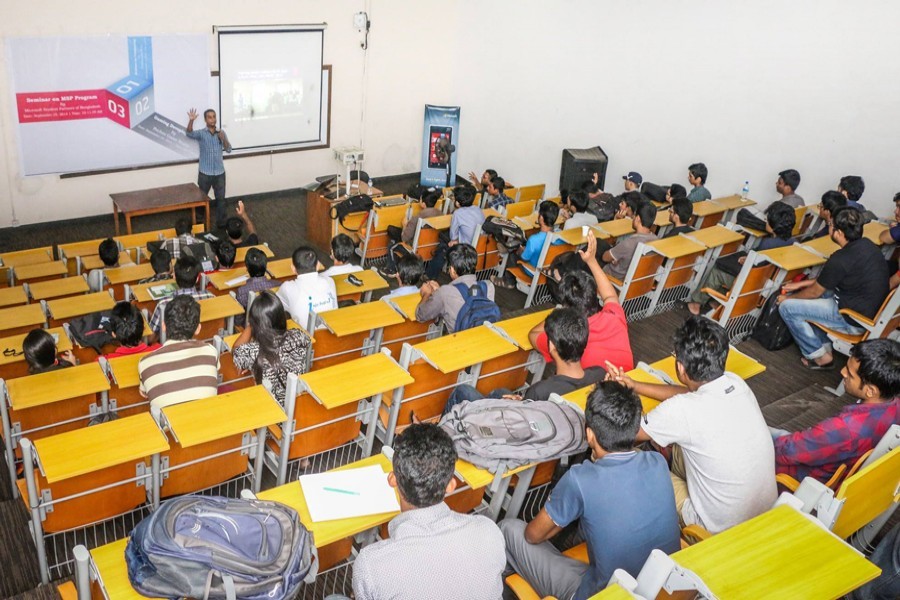The apprehension was there all right. What was however not known is the enormity of the problem of dropout and learning losses arising out of the prolonged closure of educational institutions in the country. While the number of dropout learners is countable, the extent of learning losses defies any scale in concrete terms. However immeasurable it may be depending on individual aptitude or a lack of it, family background concerning particularly parents' educational and financial statuses and willingness required for guidance, community involvement and environment, the weakness is bound to get exposed in classrooms and overall studies.
But first the case of those who were forced to prematurely bring an end to their student life on account of financial compulsions brought on them by the devastating impacts of the Covid-19 pandemic and post-pandemic adverse situation. According to the University Grants Commission, a total of 0.249 million university students discontinued studies between 2020 and 2021. The data from the Bangladesh Bureau of Bangladesh Educational Information and Statistics (Banbeis) show that 62,104 students dropped out of secondary schools during the same period. However, there seems to have been a tsunami of dropouts at the primary level of education with 1.45 million young learners missing from the account.
The United Nations Educational, Scientific and Cultural Organisation (UNESCO) forewarned during the pandemic of a lost generation the long-time closure of educational institutions would create. Call it the missing or lost generation whatever you like, the fact remains that 1.762 million students enrolled with educational institutions in Bangladesh are likely not to live up to their potential whatever that might have been. There is doubt if a significant number of them will be overachievers rather than underachievers in terms of their life's stations. No doubt, an overwhelming majority of them will find themselves and their next generation in the underdevelopment trap similar to the poverty trap.
It is not only the young generation of Bangladesh that is going to count the cost for pandemic-related economic turmoil. No wonder, the Unicef reported in 2021 the increase in child labour worldwide for the first time in 20 years. Both the authorities here and the international community failed to devise a plan for keeping students at all levels engaged in studies and not falling victim to learning losses. Even when normalcy returned, there was no policy or plan for putting in place a set of instruments or system for stimulating the dropouts to return to classes. When this is the case with the missing students, any strategy geared to helping learning recovery is indeed a far cry.
Where did the missing learners land then? It is common knowledge that even underage children either had to opt for child labour or child brides most often against their will. Menial labour for a pittance has seen the youngsters' dreams go up in smoke. The Directorate of Secondary and Higher Education (DSHE) reports on the basis of survey that 50,000 girl students were married off and more than 80,000 became child labourers in 2021 alone. Their elders or adult students also chose occupations they perhaps would not have to choose if they could complete their studies. This way they simply had to bury their dreams and come to terms with something well below their expectation.
Even those who have been fortunate enough to pursue their studies learnt less than they were supposed to do. The two public examinations of Secondary School Certificate (SSC) and the Higher Secondary Certificate (HSC) held on curtailed syllabi, papers and total marks bear testimony to this. Its impact will be felt by them in their higher studies, careers and creative pursuance.
There was no attempt, programme or extra classes to bridge the learning gap. But beginners without 'foundational knowledge' have been promoted to the next classes. The result is likely to be disastrous. So far this highly important issue of arming the beginners at the primary stage with the basic knowledge has not been paid any attention to. It is against this backdrop, the new education curriculum has been introduced on a piecemeal basis. This too without preparing teachers for taking up the challenge of imparting pragmatic knowledge and doing away with examinations for young learners. As if the teachers accustomed to imparting lessons in a conventional method will suddenly acquire a magic wand each to do miracle with child psychology, their aptitudes and mood swings!
On the other hand, children are not all angels nor are their teachers dedicated souls always in search of inventing ways of drawing the attention of their young charges so as to keep them spellbound or mesmerised. There is no point raising hell out of the mistakes in textbooks. Those can and will be corrected which along with further edition is done everywhere in order to stay updated. But the knowledge gap is what cannot be made amends for unless addressed timely. The most important question is to equip students with theoretical knowledge that they know how to apply in practical life. So, there is every chance of a mismatch with the introduction of the new academic curriculum on account of the lacking in preceptors' knowledge, training and commitment.


